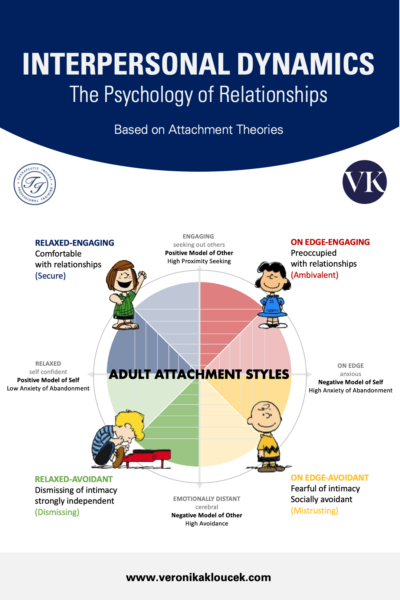
Understanding Attachment Styles: The Foundation of Human Relationships
by Veronika | Sep 11, 2016
Have you ever wondered why some people get along splendid whilst others constantly seem to collide? Attachment theory, a groundbreaking psychological framework originated by John Bowlby in the 1960s and further developed by Mary Ainsworth and many others in the field, has been instrumental in understanding the dynamics of human relationships and how early experiences shape our personality.
At its core, attachment theory seeks to understand how individuals form emotional bonds, react to separation, and seek proximity or independence within relationships. By plotting attachment styles on a matrix with axes measuring tolerance of abandonment and proximity seeking, we can explore the four primary attachment styles: autonomous (secure) attachment, preoccupied (insecure/anxious) attachment, dismissing (insecure/avoidant) attachment, and fearful-avoidant (disorganised) attachment.
Attachment Styles on a Matrix
To comprehend the four primary attachment styles, we can visualise them within a matrix:
- Tolerance of Abandonment (Low to High): On one axis, we measure an individual’s emotional tolerance for abandonment. Low tolerance suggests a heightened fear of abandonment and rejection, while high tolerance implies a more relaxed attitude toward separations and the potential end of relationships.
- Proximity Seeking (Low to High): The other axis evaluates an individual’s desire for physical and emotional closeness within relationships. Low proximity seeking indicates a preference for independence and emotional distance, while high proximity seeking reflects a strong need for intimacy and closeness.

The Four Primary Attachment Styles:
- Autonomous (Secure) Attachment: Placing high on both the tolerance of abandonment and proximity seeking axes, individuals with autonomous attachment styles feel secure within themselves and their relationships. They have a balanced perspective on attachment, valuing both independence and intimacy. These individuals typically had caregivers who were consistently responsive to their needs during infancy, allowing them to develop trust and confidence in relationships.
- Preoccupied (Insecure/Anxious) Attachment: High in proximity seeking but low in tolerance of abandonment, preoccupied individuals are often characterised by intense emotional needs and fears of rejection. They may become anxious and overly dependent on their partners, fearing abandonment and seeking constant reassurance. Their attachment style is often rooted in inconsistent caregiving during childhood.
- Dismissing (Insecure/Avoidant) Attachment: Individuals with dismissing attachment styles score low on both the proximity seeking and tolerance of abandonment axes. They prioritise independence and self-sufficiency, often distancing themselves emotionally from others. They may find it challenging to rely on others or express vulnerability in relationships, reflecting a history of caregivers who were unresponsive or emotionally distant during their formative years.
- Fearful-Avoidant (Disorganized) Attachment: Positioned in the high proximity seeking and low tolerance of abandonment quadrant, fearful-avoidant individuals exhibit a complex relationship with attachment. They may have a strong desire for intimacy but are simultaneously overwhelmed by the fear of getting hurt. This attachment style often arises from experiences of inconsistent caregiving or traumatic childhood events.
Implications for Adult Relationships
While individuals possess the capacity for all attachment styles, their default style tends to surface when they are under pressure or facing significant stressors as is often the case in romantic or work relationships. This default style guides how they cope with challenges, navigate relationships, and make decisions.
Securely attached individuals tend to form stable and fulfilling partnerships, while those with insecure attachment styles may encounter challenges related to excessive neediness (preoccupied), emotional distance (dismissing), or unpredictable behaviour (fearful-avoidant).
Recognising one’s default attachment style is essential for personal growth and relationship dynamics. It allows individuals to understand their tendencies under pressure and empowers them to adopt healthier coping mechanisms and communication strategies.
It is also crucial to acknowledge that attachment styles can evolve and change over time, particularly with self-awareness and therapeutic interventions. A mutually supportive relationship, in private life or at work, can also be an environment for change so long as both parties are open to communication and committed to doing self development work.
In summary, attachment theory offers a framework to comprehend the dynamics of human relationships. Understanding how individuals react to pressure and stress in their relationships can promote a mutually supportive environment. While everyone has the capacity for all attachment styles, recognising one’s default style is crucial for personal development and improved relationship dynamics. By acknowledging these patterns and working on self-awareness, individuals can strive for healthier, more fulfilling connections, and navigate challenging situations with greater resilience and understanding in both personal life and the work environment.
If this article resonates with you and you would like to find out more for yourself or your organisation about how we can help you increase your stress resilience and help prevent burnout, schedule a confidential enquiry call today!
Veronika Kloucek, Senior Psychotherapist, Trainer, Coach

